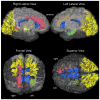White matter volume abnormalities and associations with symptomatology in schizophrenia
- PMID: 20538438
- PMCID: PMC2913317
- DOI: 10.1016/j.pscychresns.2010.04.016
White matter volume abnormalities and associations with symptomatology in schizophrenia
Abstract
The cerebral white matter (WM) is critically involved in many bio-behavioral functions impaired in schizophrenia. However, the specific neural systems underlying symptomatology in schizophrenia are not well known. By comparing the volume of all brain fiber systems between chronic patients with DSM-III-R schizophrenia (n=88) and matched healthy community controls (n=40), we found that a set of a priori WM regions of local and distal associative fiber systems was significantly different in patients with schizophrenia. There were significant positive correlations between volumes (larger) in anterior callosal, cingulate and temporal deep WM regions (related to distal connections) with positive symptoms, such as hallucinations, delusions and bizarre behavior, and significant negative correlation between volumes (smaller) in occipital and paralimbic superficial WM (related to local connections) and posterior callosal fiber systems with higher negative symptoms, such as alogia. Furthermore, the temporal sagittal system showed significant rightward asymmetry between patients and controls. These observations suggest a pattern of volume WM alterations associated with symptomatology in schizophrenia that may be related in part to predisposition to schizophrenia.
Copyright 2010 Elsevier Ireland Ltd. All rights reserved.
Figures



References
-
- Andreasen NC, Arndt S, Swayze V, 2nd, Cizaldo T, Flaum M, O'Leary D, et al. Thalamic abnormalities in schizophrenia visualized through magnetic resonance image averaging. Science. 1994;266(5183):294–298. - PubMed
-
- Andreasen NC, Nopoulos P, O'Leary DS, Miller DD, Wassink T, Flaum M. Defining the phenotype of schizophrenia: cognitive dysmetria and its neural mechanisms. Biological Psychiatry. 1999;46(7):908–920. - PubMed
-
- Andreasen NC, Olsen S. Negative versus positive schizophrenia. Definition and validation. Archives of General Psychiatry. 1982;39:789–794. - PubMed
-
- Annett M. A classification of hand preference by association analysis. British Journal of Psychology. 1970;61(3):303–321. - PubMed
-
- Argartz I, Andersson J, Skare S. Abnormal brain white matter in schizophrenia: A diffusion tensor imaging study. Neuroreport. 2001;12(10):2251–2254. - PubMed
Publication types
MeSH terms
Grants and funding
LinkOut - more resources
Full Text Sources
Medical

